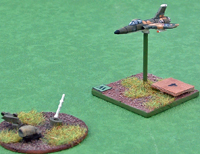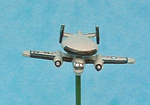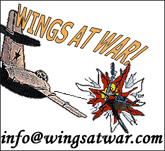Vietnam 1965-72
![]()
The South East Asia War (more commonly known as the Vietnam War) like the Korean war was a product of the aftermath of WW2. After the surrender of the Japanese occupying force the Viet Minh communist guerrillas, who had fought against the Japanese, declared independence from France. America, fearful of communist encroachment, supported the restoration of the old colonial power and French administration was reinstated.
Following a crushing defeat at Dien Bien Phu the French agreed to a ceasefire in 1954 and Vietnam was officially divided into a communist north and an independent south. Conflict between the two soon led to the Americans lending an increasing amount of material and advisory assistance to the military forces of the Republic of South Vietnam.
Tensions increased and in 1964
US carrier aircraft mounted several strikes against the North in
retaliation for guerilla attacks on American ships and air bases.
Within months American ground troops arrived in South
 Vietnam and with
the help of massive uncontested air-support took on the Viet Cong
guerrillas. South Vietnam was physically divided from the North
by the Demilitarised Zone (DMZ) and US ground troops would not cross
that line. The justification for the war was to stop communist encroachment
in Southeast Asia and escalation would be a whole other can of worms.
The only way to teach the North a lesson was by airpower.
Vietnam and with
the help of massive uncontested air-support took on the Viet Cong
guerrillas. South Vietnam was physically divided from the North
by the Demilitarised Zone (DMZ) and US ground troops would not cross
that line. The justification for the war was to stop communist encroachment
in Southeast Asia and escalation would be a whole other can of worms.
The only way to teach the North a lesson was by airpower.
Facing the Americans were around a hundred Soviet designed jet fighters along with thousands of anti-aircraft guns and hundreds of surface-to-air missiles. The US plan was to stage a series of increasingly powerful strategic strikes designed to destroy the North's ability to support the Viet Cong and to make their leaders see the error of their ways; and ultimately sue for peace. The plan was to be fatally compromised by the White House who imposed strict political control on every facet of the campaign including choice of targets. President Johnson boasted that the Air Force "can't even bomb an outhouse without my approval". They also defined large areas of North Vietnam as off-limits and imposed protracted periods of pauses and ceasefires in which offensive action was not allowed, though the notoriously wet and stormy weather of Southeast Asia often put a limit on operations anyway.
Rolling Thunder
In 1965 the Rolling Thunder bombing campaign
against North Vietnam was initiated and in a sobering first raid
by USAF F-100s, F-105s and B-57s supported by RF-101s five aircraft
were lost to AA fire. Soon after, American planes began to clash
with their counterparts in the North Vietnamese People's Army Air Force (VPAAF).
Army Air Force (VPAAF).
The Americans always had far more planes than their opponents, the NVPAAF averaged around one hundred aircraft at any one time. However, several factors helped to even up the odds. USAF aircraft were based in the far off but safe haven of Thailand several hundred miles from their targets and each US air strike had to be accompanied by scores of support planes such as tankers (a mission could involve several inflight-refueling stops) radar jammers, Wild Weasel defence suppression planes, forward air controllers, chaff dispensers, helicopter rescue and MiG combat air patrol.
The North Vietnamese could use their radar to track every movement and vector their fighters to the most advantageous position. Though many of the American planes were fitted with radar the crew could only fire at a target if they had a positive visual ID; MiGs were small and almost impossible to spot beyond a couple of miles. Most limiting of all, until late in the campaign, political considerations meant that the main cities of Hanoi and Haiphong plus a wide buffer zone bordering China, and worse of all every enemy airbase, were strictly out of bounds for fear of causing casualties amongst Russian and Chinese 'advisors'.
North Vietnam was divided by the Americans into a series of Route Packages, numbered from I to VI (the latter sub-divided into VIa and VIb). The higher the number, the more lucrative the target, but the more dangerous the mission. For the USAF, the burden fell mainly on the F-105 Thunderchief. 'Thuds' flying out of Thailand would approach RP VI by looping round from the north in order to use the radar and SAM cover provided by the high rugged karst ridges that point towards Hanoi. Chief among these was Thud Ridge.
Yankee Station
America's giant aircraft carriers operated from Yankee Station in the Gulf Of Tonkin, less than 200 miles from their targets, and their aircraft could make a more direct approach straight off the sea. The US Navy ended up flying the majority of sorties over North Vietnam; 52% as opposed to 43% by the USAF and 5% by the Marines.
Typically, a carrier would have two squadrons
of F-8s (F-4s on the giant nuclear
 carriers)
and three or four squadrons of A-4 attack planes, though to begin
with one of the squadrons could instead be A-1 Skyraiders or A-3
bombers. Towards the end of the war a large carrier would operate
two F-4, one A-6 and two A-7 squadrons. Added to a carrier's complement
would be a dozen or more support types such as reconnaissance, ECM
planes and tankers. The Marines tended to use their carrier types
to fly from land bases just south of the DMZ.
carriers)
and three or four squadrons of A-4 attack planes, though to begin
with one of the squadrons could instead be A-1 Skyraiders or A-3
bombers. Towards the end of the war a large carrier would operate
two F-4, one A-6 and two A-7 squadrons. Added to a carrier's complement
would be a dozen or more support types such as reconnaissance, ECM
planes and tankers. The Marines tended to use their carrier types
to fly from land bases just south of the DMZ.
North Vietnamese tactics were aimed at spoiling the US effort, forcing the attackers to drop their bombs before reaching the target whilst avoiding losing MiGs if at all possible. Communist pilots gradually became more aggressive and willing to mix it with the Americans. Thirteen VPAAF pilots eventually became aces. Notably effective were the masses of radar-aimed anti-aircraft guns and Soviet SA-2 surface-to-air missiles which formed a deadly air defence network The missiles were not particularly accurate, for instance they managed to shoot down thirty Phantoms during the war whereas thirty-three F-4s were destroyed by MiGs, but they could induce the Americans into becoming cautious and liable to panic at the mere mention of SAMs. AA gunfire proved the most deadly enemy accounting for 307 Phantoms in 1966 alone.
Rolling Thunder rumbled on at enormous cost for over two years, to little positive effect. Severe damage was caused, but the North Vietnamese simply re-doubled their efforts. With pressure mounting on both sides preliminary peace talks were convened in Paris and the bombing of the North was halted.
Linebacker
After four years of fruitless wrangling the Americans decided to resume bombing over North Vietnam in 1972 in a campaign called Linebacker. US strength had been reduced in the intervening years but reinforcements, including new aircraft types, were soon flown in.
The aim was to cut off North Vietnam from the rest of the World, to destroy its stock piles of military equipment and stop it heading south to support the Viet Cong. Bombing restrictions were loosened and when the North Vietnamese launched the Tet offensive in spring B-52s were diverted to attack enemy troop concentrations north of the DMZ, the first time the giant bombers had ventured into North Vietnam. They were soon unleashed against the high value targets around Hanoi and Haiphong that for years had only been attacked by fighter-bombers and carrier attack planes.
Communist air opposition increased but could not stop the destruction. Over one hundred bridges were knocked down and over three-quarters of the North's war supplies were destroyed forcing the Communists back to the peace table. Bombing of the North was once more suspended.
After two months of yet more fruitless negotiations the Americans resumed a virtually unrestricted bombing campaign named Linebacker II. In eleven days in December B-52s flew hundreds of sorties in which factories, barracks, bridges, railways and power plants were pounded to dust. Fifteen B-52s were shot down but electric power generation had been cut by 80%. Haiphong harbour was rendered unusable by air-dropped mines, and all of the North's SAMs had been used.
This time a peace treaty was agreed, America was
desperate to get out and the North had been battered almost to the
point of submission. The US withdraw from Vietnam leaving the defence
of the south to the Vietnamese. In 1975 the North launched a massive
invasion and without US air support South Vietnam was overrun in
four weeks.
Click on the links below for more information
